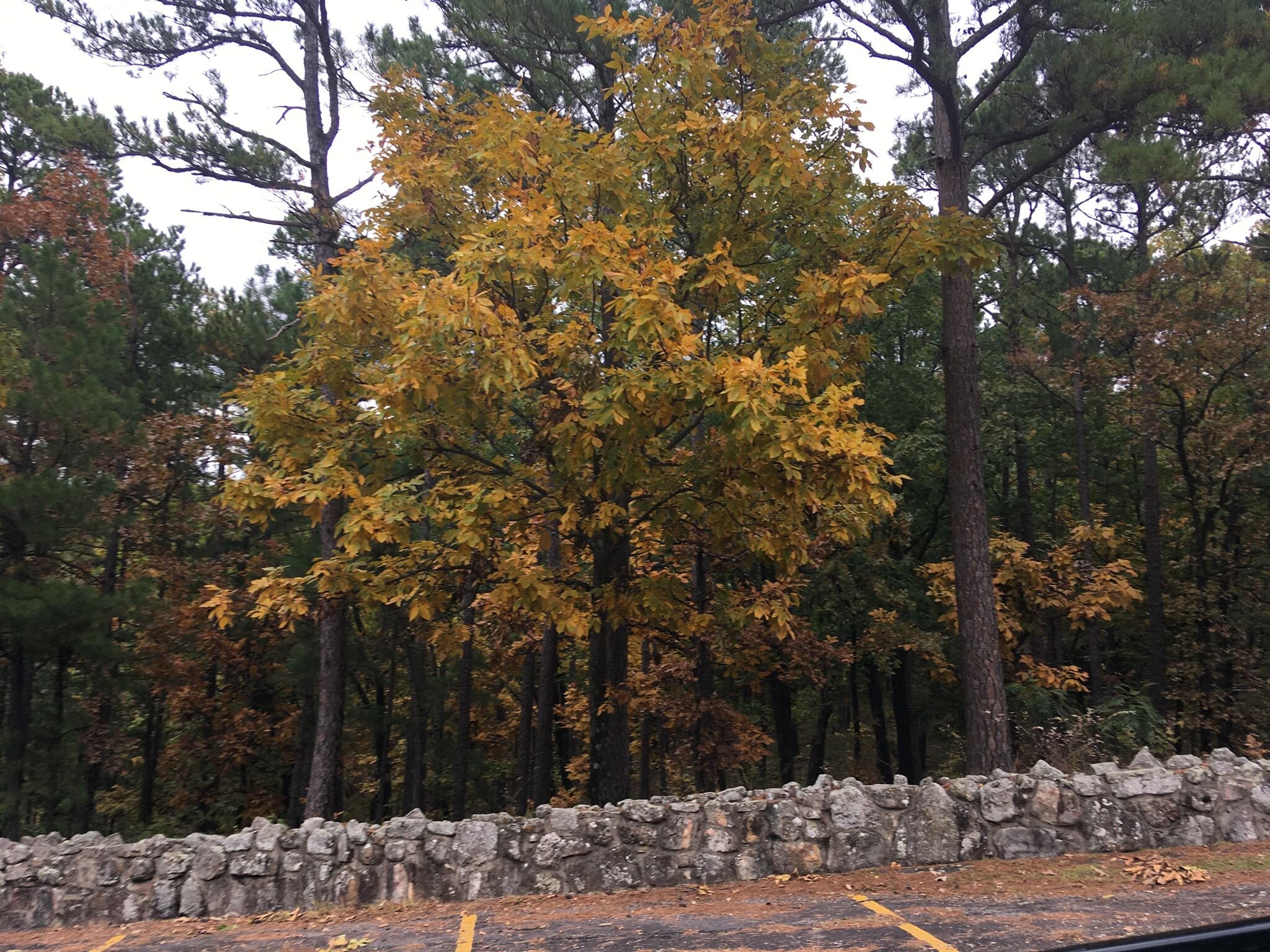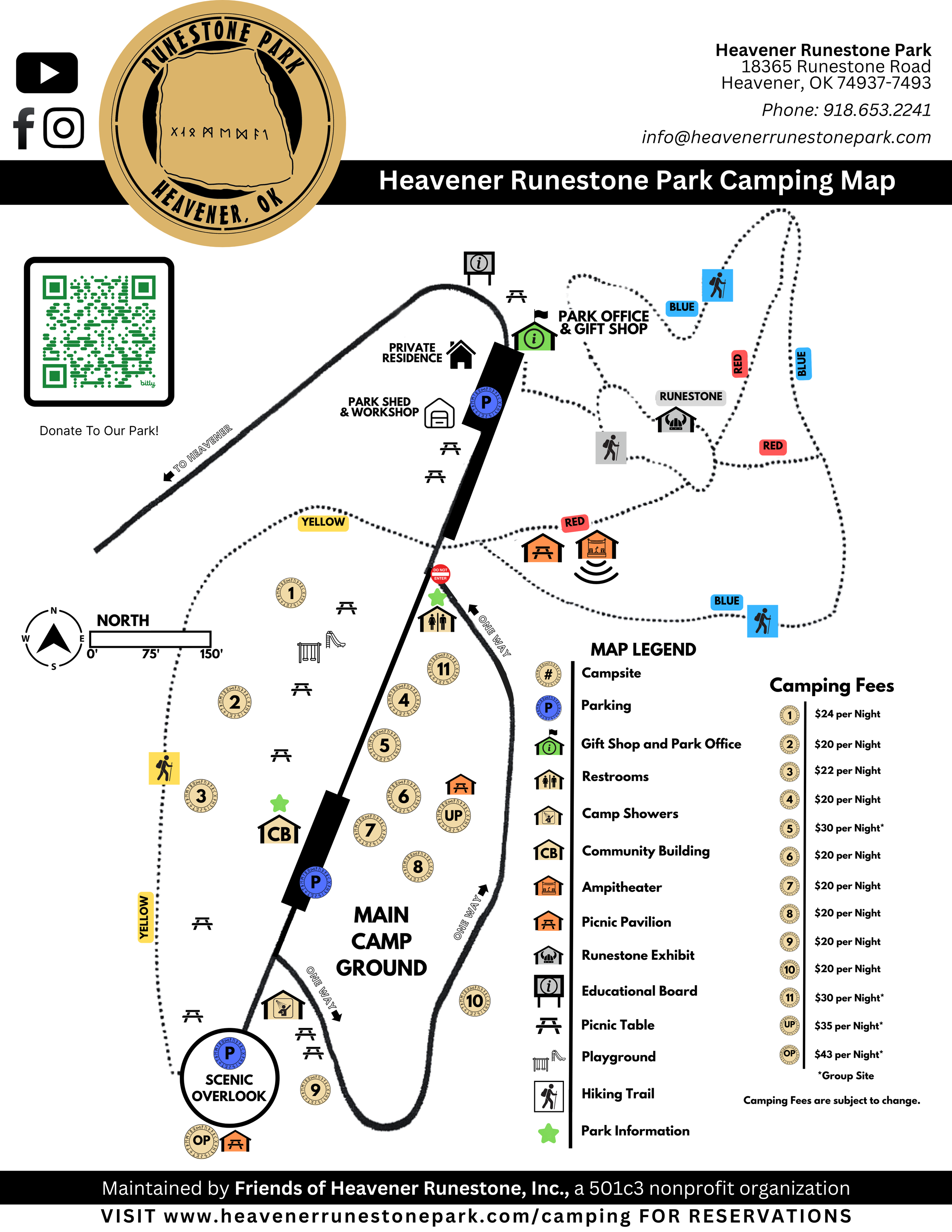
Historic Heavener Runestone Park
A former state park that is currently maintained by Friends of Heavener Runestone, Inc., a 501(c)(3) organization.
The Heavener Runestone Park is a 55 acre park best known for being the home of a large sandstone that contains 8 markings believed to have been a boundary marker created by Vikings between 600 and 800AD. This park offers a little over 2 miles of hiking trails, a scenic overlook with a view of the city of Heavener, tent camping sites, including a few with electrical hook-ups, secluded primitive campsites, limited RV hook-ups, a playground, seasonal waterfall, picnic areas, amphitheater, event center, gift shop and breathtaking views.
We are a dog friendly park, please keep your dogs on a leash at all times and clean up after them.
Wildlife often found in the park include a variety of birds such as woodpeckers and the occasional bald eagle, deer, chipmunks, squirrels, lizards, snakes, a vulture family, armadillos, opossums, and a couple wild cats that help with the rodent population. There is both a hawk and an owl that live at the lower entry to the park as well as several rabbits and a couple road runners. When visiting you may also spot a few endangered animals that make Runestone Park their home, such as bats and Red Cockade Woodpeckers.
History
The park began because of the fascination of a local Heavener girl. Gloria Farley was introduced to the massive stone in the 1920’s when she was just a child. The unique markings left an impression and got her to return once again in the 1950’s.
When Gloria was shown the stone as a child she never imagined majority of her adult life would be dedicated to researching it and making it known around the world.
She worked hard and pushed even harder to get people to hear her out and look into the history of the stone. She eventually had support from local members of government including Clem Hamilton who played a role in the park being recognized as a state park in 1970.
Over the years there has been much controversy over the authenticity of the runes. Who made them, when they made them etc. This got the attention of various researchers. Too many to list them all but a few that stand out include Dr. Richard Nielson, Dr Henrik Williams and Geologist Scott Wolter.
Here at the park we hear all sorts of theories from it being made by the Irish, the French, Egyptians, to the Knights Templar. For those with a profession in sorting this type of stuff the most agreed upon conclusion is that the markings were made between 600 and 800 AD by Vikings or Scandinavians.
Once believed to contain a date it is now believed the stone was a boundary marker or land claim. The eight runes believed to be from the Elder Futhark translate best to gnomedal or glomedal which is “Little Valley” or “Valley owned by Glome”
The park is a destination for locals as well as those from all over the world to come and just get away from everything. Find a quiet spot and relax. It is home for many family reunions that have been occurring on site for over 20 years. It provides a beautiful spot for marriage proposals and weddings as well as a family fun day in the park, surrounded by nature.
The park was a state owned and operated park from 1970 to 2011. Originally 55 acres was donated to the state by Herbert Ward. He made sure it was to remain a public park or revert back to his family. In 2011, ownership of the park was transferred to the City of Heavener who has since kept the park open to the public.
At that time, a group of local community members came together to find a way to secure donations to maintain the park and shortly after they established a 501c3 non-profit group, Friends of Heavener Runestone, Inc. While none of the founding members are involved with the corporation today, the new members continue in their efforts to keep the park open and maintained for the public to enjoy.
It's estimated the park host several thousand visitors a month. The park has hosted visitors from Oklahoma locals to visitors from across America and the globe. International visitors have traveled from locations as far away as Germany, Austria, Scotland, Bolivia, Norway, Sweden, China and Thailand just to name a few.
As a way to raise funds, FHR began having festivals throughout the years. The larger event being the Viking festival, that was held twice a year from 2012 through 2019. A switch up in 2020 was made to include a larger variety of entertainment from various historical periods. Unfortunately, this was put on hiatus due to the Covid 19 pandemic. Future plans include a return of our Viking Festival as well as a myriad of other community outreach and fundraising events.
The 55 acre park consists of a gift shop, seasonal waterfall, a little over 2 miles of nature trails, picnic areas, tent camping sites, playground, amphitheater, and a community building.
Also on site is the Park Host residence, the restrooms and the shower house. These structures were built in the 1960’s or 1970’s. During the transfer between State to City, some historical documentation of the park infrastructure was lost and currently we have no records of when some of the structures were built. There is also amazing rockwork along the pathway to the Runestone believed to have been made in the same time frame as the structures by locals that were part of a group called Green Thumb, similar to that of the Civilian Conversation Corps.
Scan QR Code to download Trail Map
Scan QR Code to download Camping Map














